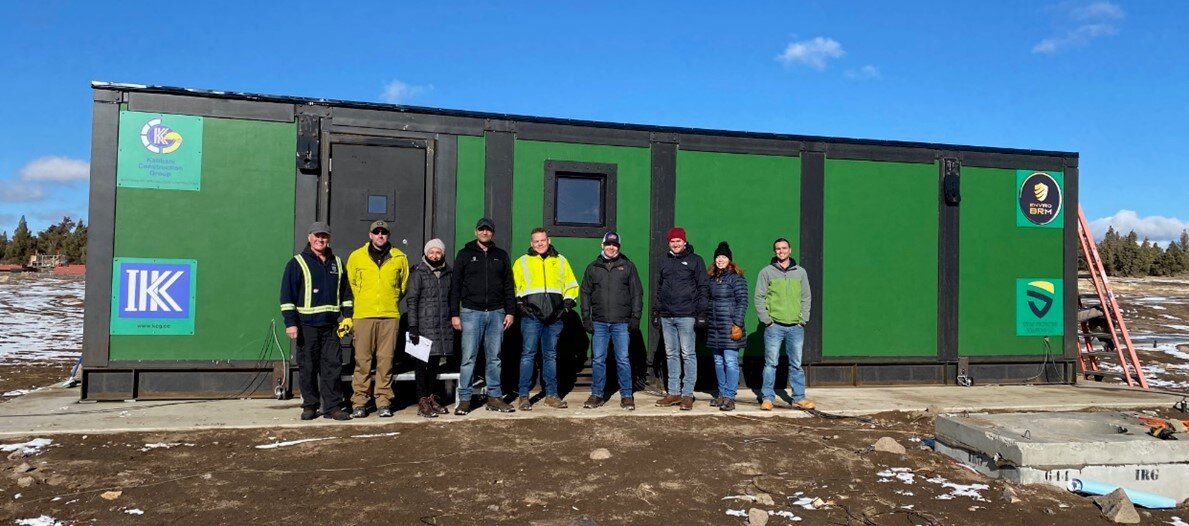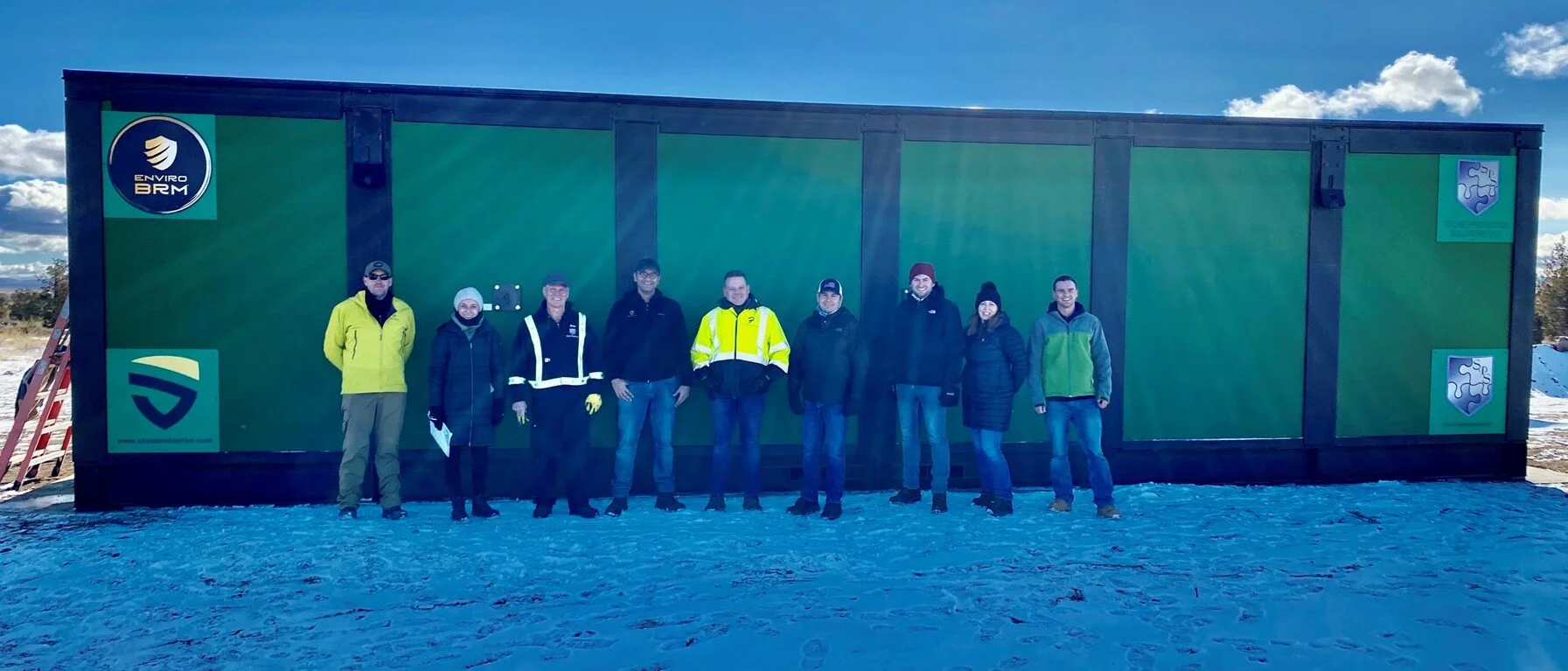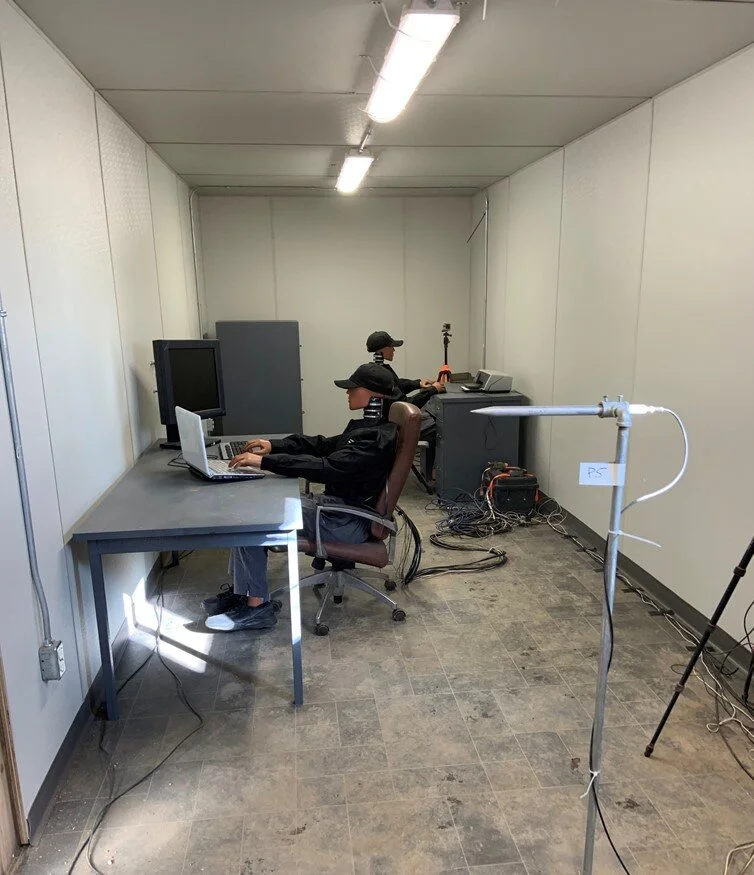Successful Blast Testing and Performance Validation of SPS, LLC Blast-Resistant Module: Enviro BRM™
On November 19-20, 2020, Stone Protective Solutions, LLC (SPS, LLC) has hosted a Blast Testing event for our blast-resistant modular product (Enviro BRM™) that integrates our patented Extreme-Woodlam™ panel technology system within our modular building steel framing design. The blast testing program was supervised by Stone Security Engineering, witnessed by a third-party (TRU Compliance) and executed by Oregon Ballistic Laboratories (OBL) at our Stone-OBL's Blast Testing Facility outside of Bend, Oregon- USA. Figure 1 and Figure 2 below show the blast test attendees during the first day of testing.
Figure 1. Blast Test Attendees at the Stone-OBL Blast Test Site (Rear Face)
Figure 2. Blast Test Attendees at the Stone-OBL Blast Test Site (Front Face)
SPS, LLC would like to acknowledge our business associates from Stone Security Engineering (blast engineer on record), Stone Protective Solutions, LTD (exclusive licensed supplier and general contractor for our Canadian Operations), and IKK/Kabbani Construction Group (exclusive license sales and manufacturing for Enviro BRM™ products in the Gulf Cooperation Council within the Middle East Region).
SPS, LLC would also like to acknowledge the outstanding assistance and performance of our material suppliers and fabricators including Freres Lumber Co., Inc. (authorized Extreme-Woodlam™ material supplier), Surelock McGill (Blast Door hardware supplier), and Trade-Mark Group (one of our manufacturers for the Enviro BRM™ products in North America).
The test program included blast testing and performance validation for our full-scale 8psi free-field overpressure Enviro BRM™ design. This blast design has been developed for a reflected pressure of 19.2 psi and up to blast loading duration of 200 msec to achieve a MEDIUM BUILDING DAMAGE RESPONSE LEVEL in accordance with the ASCE’s “Design of Blast-Resistant Buildings in Petrochemical Facilities” (equivalent to a BUILDING LOW LEVEL OF PROTECTION per CSA S850-12 “Design and Assessment of Buildings Subjected to Blast Loads”) and in compliance with recommended practices listed in API 753 for Management of Hazards Associated With Location of Process Plant Portable Buildings. Definitions for the ASCE Building Damage Response Levels are summarized in Table 1 below and definitions for the CSA Building Level of Protection are summarized in Table 2 below.
Table 1. ASCE Building Damage Level Definitions
Table 2. CSA S850-12 Building Level of Protection Definitions
The Extreme-Woodlam™ panels were supplied by Freres Lumber in Oregon and the door hardware systems were provided by Surelock McGill (through their North American operations in Kentucky). The Extreme-Woodlam™ panels and door hardware were shipped to Trade-Mark Group. The full Enviro BRM™ unit was then fabricated, assembled and shipped out from the Trade-Mark fabrication facility as shown in Figure 3 below. The Enviro BRM™ was delivered to the blast test site outside of Bend, Oregon (as shown in Figure 4) on November 11, 2020.
Figure 3. Fabricated Enviro BRM™ Unit Shipped out from Trade-Mark Fabrication Facility
Figure 4. Delivery of the Enviro BRM™ Unit to the Stone-OBL Blast Test Site
Open-Air Arena Blast Testing for one unanchored 10-ft wide x 40-ft long x 11-ft high blast-resistant module placed on a reinforced concrete slab positioned 131 feet from the explosive charge was executed. Three thousand pounds of ammonium nitrate/fuel oil (ANFO), a widely used bulk industrial explosive mixture was used as the energetic material to develop the test blast loading of 9-10 psi free-field overpressure range (25-26 psi reflected) and average free-field impulse of 85 psi-msec (average reflected impulse of 212 psi-msec). Figure 5 illustrates a view of the test-arena setup (pre-test) with the energetic material placed in the sonotube at the set location facing the reflected surface of the Enviro BRM™ unit.
Figure 5. View of Blast Arena Layout with Explosive Charge (Pre-Test)
The instrumentation for the blast testing included pressure gauges, accelerometers, linear encoders, Anthropomorphic Test Devices (ATDs) along with high-speed and real-time videos and photos. The collected documentation has been used to confirm the applied blast loading and building component responses to the blast event to validate the building response and to further validate the analytical dynamic design models and details for the Enviro BRM™ units for various blast ranges. For the applied blast test loading, our pre-test analytical modeling estimated up to a LOW BUILDING DAMAGE RESPONSE per ASCE criteria (equivalent to a BUILDING MEDIUM LEVEL OF PROTECTION per CSA S850-12). Figure 6 below shows pre-test photos of the Enviro BRM™ with the some of the instrumentation set inside and outside the building.
Figure 6. Pre-Test Photos of Enviro BRM™ with Instrumentation- Exterior and Interior
Figure 7 below shows the Enviro BRM™ at the time of the explosive charge detonation. Two representative videos shown below record the blast testing event (one exterior and one interior).
Figure 7. Enviro BRM™ Unit at the Time of Detonation
Post-blast testing visual observations, photo and video documentation show a NO DAMAGE BLAST RESPONSE to the individual wall, floor, roofing and glazing components. The door and associated hardware remained closed during the blast detonation event and were fully operable after the blast event with no damage to the door leaf, framing, door latch and closer hardware systems and very minor insignificant damage limited to two screws at one door hinge and minor non-structural roof flashing damage, which are all easily repaired. No Damage and no debris from the interior finishing, electrical lines, overhead lighting and furniture was also recorded. Overall accelerations and sliding motion of the Enviro BRM™ unit and its contents where at a minimum and within the acceptable ranges. Figure 8 shows post-test photos of the Enviro BRM™ unit to illustrate the NO DAMAGE BUILDING RESPONSE and building is fully functional post-blast event (equivalent to a BUILDING HIGH LEVEL OF PROTECTION per CSA S850-12).
Figure 8. Post-Test Photos of Enviro BRM™ (Exterior and Interior) with NO DAMAGE RESPONSE
The documented response also aligns well with not exceeding the pre-test predicted analytical response of a LOW BUILDING DAMAGE per ASCE criteria noted above for the associated test load, thus validating the overall blast/structural designs and details and associated dynamic modelling prediction tools developed for them. Overall, the full-scale testing of the BRM and data collected have validated the analytical modeling tools and confirm that our Enviro BRM™ designs with the applied full duration of 200 msec will achieve a MEDIUM BUILDING DAMAGE RESPONSE LEVEL in accordance with the ASCE’s “Design of Blast-Resistant Buildings in Petrochemical Facilities” (equivalent to a BUILDING LOW LEVEL OF PROTECTION per CSA S850-12 “Design and Assessment of Buildings Subjected to Blast Loads”) and in compliance with recommended practices listed in API 753 for Management of Hazards Associated With Location of Process Plant Portable Buildings.













